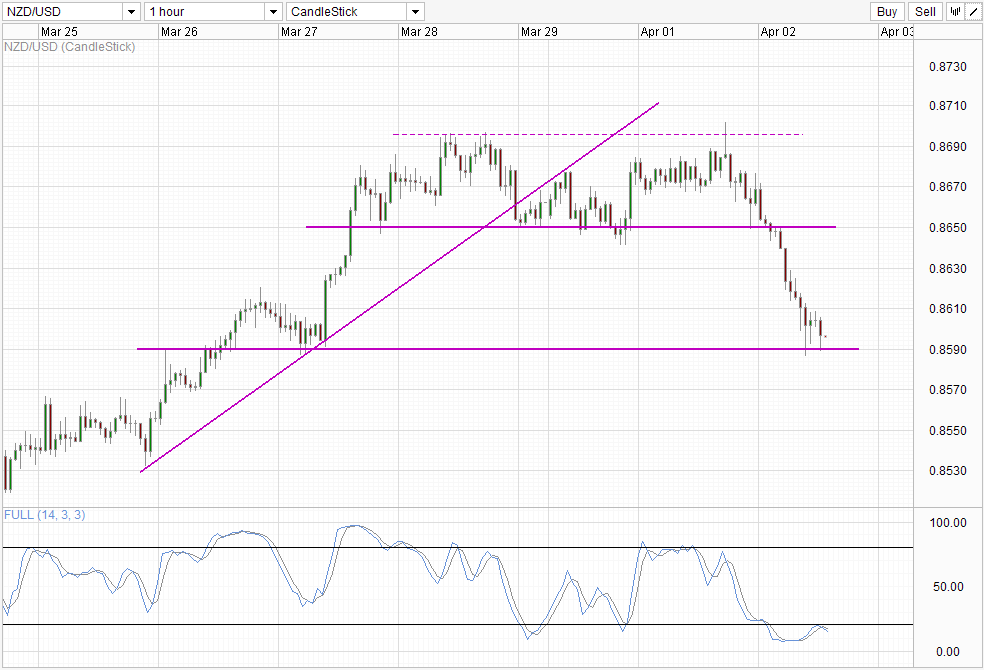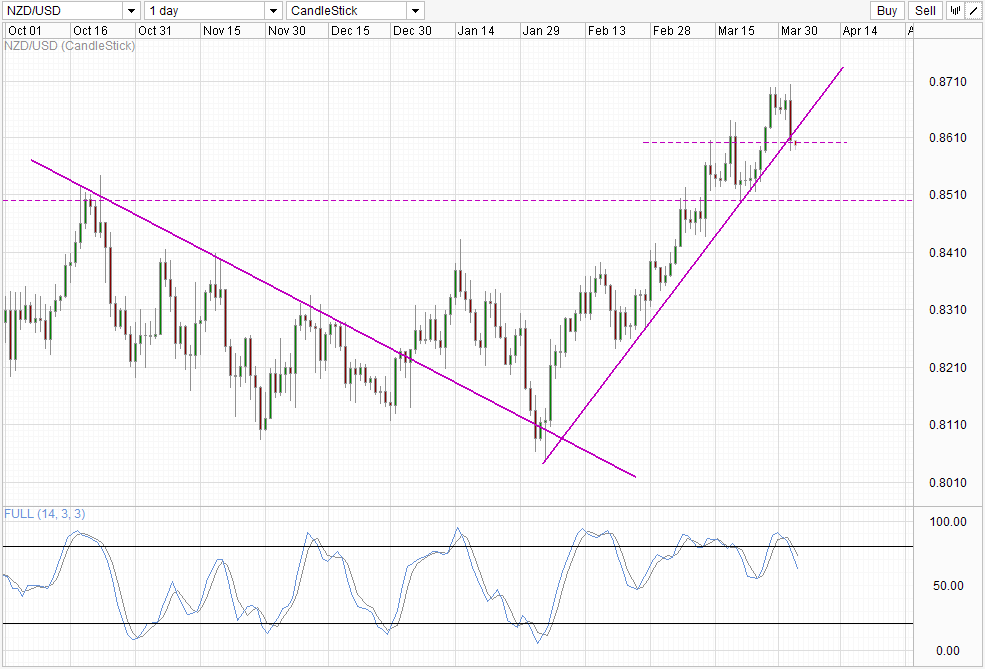Kiwi dollar suffered significant decline after the failure to break 0.87 round figure. This decline is surprising as broad risk trends is bullish evident via global stock indexes that managed to climb higher. Some may argue that USD is strengthening due to inflow of funds as foreign investors are attracted by US stocks which are hitting record highs yet again. But the USD strengthening narrative is not visible via EUR/USD and GBP/USD. AUD/USD did trade lower but that appears to be spillover from NZD/USD affecting its neighbor rather than a case of USD pulling everybody down.
It should also be noted that the decline in NZD/USD continued with great fervor during Asian session today when all other major currency pairs have been trading higher against USD or at the very least stabilized. Hence, it is reasonable to assert that NZD/USD is moving by its own inherent bearishness. The reason for this bearishness may be due to over saturation of bullish positions on NZD/USD. This is not surprising as going long on NZD was a straight forward trade in early 2014 as central bank RBNZ has stated explicitly that they’ll be hiking throughout 2014 – 2015. Rate expectations have not changed, but given that market participants have had such a long period of time to load up long positions, it is likely that those who are bullish have reached their purchase limit and what we are seeing is basically profit taking activities before the next bullish wave.
Hourly Chart
This would mean that overall bullish momentum should still remain intact. As such, the likelihood of 0.859 support holding becomes higher. Stochastic readings are also heavily Oversold right now, favoring a bullish reversal move higher. However, should prices fail to break resistance around 0.862 (swing high on 26th Mar) then it is likely that immediate momentum is still bearish and we could see further selling towards 0.853 – 0.856 consolidation before bulls start to buy into NZD/USD once again.
Daily Chart
Daily Chart agrees with the bearish scenario as prices appears to have broken the rising trendline and the 0.86 round figure. Stochastic indicator on the Daily Chart agrees, indicating that a bearish cycle is underway. However, it is unlikely that prices will be able to break the 0.85 necessary in order to invalidate current bullish breakout as bearish cycle is likely to be within Oversold region when that happen. This is coherent with our analysis above which assert that the decline seen in NZD/USD right now is just a temporary setback while direction wise we should still expected NZD/USD to be bullish.
It is also important to note that given current current bullish trend that is still in play, there is a chance that prices may start to reverse higher without even testing 0.850 round figure. As such, traders who want to short NZD/USD should price breaks 0.859 will need to be aware of this and adjust risk/position size accordingly.
On a side note, there are some commentary that believes that what Prime Minster Key said this morning regarding fiscal controls aimed to weaken NZD is a significant contributor to the decline yesterday. But astute traders would immediately notice that prices started declining way before Key started his speech, and also generally it is difficult for a Government/Central Bank to influence a free floating currency unless the market is supportive of the move. As such,
More Links:
WTI Crude – Staying Above 100.0 After Yesterday’s Sell-Off
S&P 500 – Weak Fundamentals? Market Does Not Care As Record High Reached
AUD/USD – Aussie Unable to Hold Onto Gains After RBA Rate Decision
This article is for general information purposes only. It is not investment advice or a solution to buy or sell securities. Opinions are the authors; not necessarily that of OANDA Corporation or any of its affiliates, subsidiaries, officers or directors. Leveraged trading is high risk and not suitable for all. You could lose all of your deposited funds.





